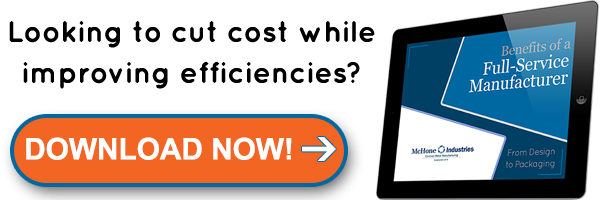
Starting as early as 1967, laser cutting proved to be a versatile and efficient means of fabricating sheet metal. Currently, it's still one of the most cost-effective and precise methods of sheet metal fabrication available. Here are 5 major reasons to choose laser cutting for your project!
Benefits of Laser Cutting for Sheet Metal Fabrication
The top five benefits of specifying laser cutting for your sheet metal fabrication project include:
- Relatively low cost
- Speed & efficiency
- Automation
- High precision
- Great versatility
Here are more details on each benefit:
1. Relatively Low Cost
The cost of laser cutting, like most other manufacturing processes, is determined by labor, operation, and machine costs (tools, dies, upkeep, etc.).
Because laser cutting is a CNC highly automated process, labor costs are minimal compared to hand-operated machinery. Operating costs and machine costs fall in the middle of the road compared to other cutting techniques.
Outsourcing laser cutting is the best option for most projects -- laser cutting machines can cost upwards of $1,000,000. If you hire a manufacturer who already has laser cutting capabilities, this cost is greatly mitigated.
Further, because a laser doesn't get dull or worn, you don't need to worry about die changeover mid-process. That means the bigger the order you place, the more cost-efficient laser cutting becomes, since you can flip a switch and let it run. The bigger your order, the more cost-effective the entire process will be.
Overall, laser cutting isn't the cheapest cutting technology available, but it's more than affordable for most projects - especially compared to waterjet or hand cutting processes.

2. Speed & Efficiency
A laser can move as quickly as 20-70" per minute. The exact speed will vary depending on tolerances and intricacy of the parts.
Manufacturing speed will increase if you have a multi-head laser or multiple lasers working at once.
3. Automation
Laser cutting is entirely run by CNC controls. The formulas entered into the computer means each part and product is identically fabricated -- that means fewer defects per batch.
4. High Precision
Laser cutting can create incredibly small cuts at tight tolerances (.005" on average). That's the tradeoff: the more precision you want, the slower the laser will move. However, this highly detailed capability is unique to laser cutting. So, if you require intricate cuts, laser cutting is the only type of cutting that will do the job well.
All laser cut edges and curves are smooth, sharp, and clean. There is very little, if any, burring because the laser melts rather than physically cuts the metal.
The only thing to consider is if your project requires very thick sheets of metal - thicker metals affect the quality of the cut, and a laser will leave some dross (melted metal scum) behind on thick metals. Aside from this dross, there is little to no clean up involved in the majority of laser cutting projects.
5. Hugely Versatile
Cost, speed, automation, and precision come together to make laser cutting perfect for any size product or project. It makes a lot of things simple and easy, including:
- Prototypes
- Industrial orders
- Delicate designs
- Larger cutouts
Automation allows for fabrication within a cutting run, no switching of dies or movement of sheet metal. Lasers are capable of making holes, slots, tabs, and other cut fabrications with no interruption of the cutting process.
The incredible precision allows for tolerances of +/-.002" (at slowest speed) on intricately detailed designs. If you don't need tight tolerances, the laser can move very quickly and produce parts at incredible speeds. This makes laser cutting fantastic for a wide spectrum of projects.
Is Laser Cutting Right for You?
In general, laser cutting is best for large orders, tight tolerances, and intricate designs. If that fits your project description, laser cutting might be best for you. If you're not sure, there are plenty of laser cutting resources available, and we're happy to discuss whether laser cutting is right for your project if you prefer to talk to an expert directly.
(EDITOR'S NOTE: This article was originally published in April 2016 and was recently updated.)


